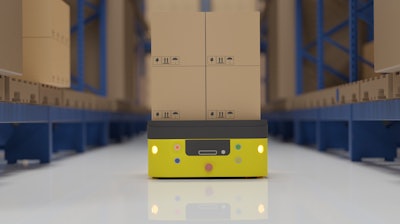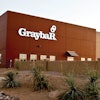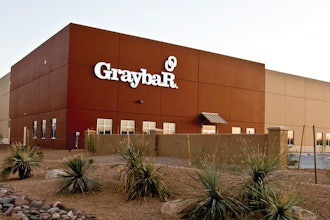
Are you considering automating your existing warehouse storage or order fulfillment applications?
Automatic Storage and Retrieval Systems (ASRSs) use robots to move and store goods, creating opportunity for higher storage heights in a denser storage array and increasing utilization of storage volume within buildings. ASRSs have seen exponential growth in the last decade and will only continue to grow as technology becomes more cost-effective, more reliable, and manufacturers offer a wider array of solutions.
While these ASRSs have many benefits, they also can create significant risk concerns. In general, there is limited guidance in the accepted fire protection standards, and many ASRS arrangements fall outside of this guidance. It may be appropriate or even necessary to consider a performance-based design approach, including large-scale fire testing.
How do ASRSs Impact Fire Sprinkler Systems?
When considering ASRS for your facility, be sure to consider the impact to existing fire sprinkler systems. Too often, the fire protection systems are overlooked. Many building owners or users assume if their building is sprinkler-ed, then the building is protected if there is a fire event, without understanding not all fire sprinkler systems are equal. Also, a fire detection system may be required to automatically shut down the ASRS during a fire event.
NFPA 13, Standard for the Installation of Sprinkler Systems, is the most prevalent sprinkler installation standard used to determine how to design fire sprinkler systems based on what’s being stored and how it’s stored. NFPA 13 addresses how to protect traditional storage arrangements (e.g., rack storage, shelf storage, solid pile, palletized, bin box, etc.), however, it does not yet address the more complex ASRSs. FM Global Property Loss Prevention Data Sheet (FMDS) 8-34 – Protection for Automatic Storage and Retrieval Systems, is the most comprehensive ASRS fire protection standard publicly available, but does not encompass all types of ASRSs, nor products.
Changes to Commodity Hazards
It is important to understand that every product in your warehouse burns differently. How a product burns also depends on how it’s packaged and how it’s stored. Is the product in a cardboard box? Does the box have extruded polystyrene foam packaging? Are the boxes stacked on a wooden or plastic pallet? These are just a few of the many variables to consider.
In prior decades, it was common for goods to be packaged inside cardboard boxes (cartoned), with these boxes stacked on a wooden pallet. Often these pallets were unloaded manually and stacked on another pallet for outbound distribution. A newer trend is inbound pallets are disassembled with packaged goods placed in plastic totes. The totes are then stored in a dense storage array.
Plastics and synthetic materials burn more readily and rapidly than common non-plastics and organic materials. Today, consumer goods include more plastics, synthetic materials and fewer metals or organic materials. In a fire event, any exposed cardboard generally becomes involved in the fire and fire growth much sooner than the products inside. After the fire sprinkler system activates, the unburned cardboard absorbs water, slowing the fire spread. However, when that same product is placed inside of a plastic tote, the exposed plastic becomes the primary material initially involved in the fire growth. Fires involving plastic grow faster and hotter. Water discharging from the sprinkler system does not absorb into the exposed surface, so the fire can spread more rapidly.
Protection Strategies for Open-Top Containers
When utilizing an FMDS 8-34 prescribed fire protection design for ASRS, products of a higher hazard than plastics are outside the scope of the standard. This means many aerosols, ignitable liquids, flammable gases, and other special hazards cannot be stored in the ASRS array.
To complicate the hazard even more, many times these plastic totes are open-top containers, which introduces additional risk from a fire protection perspective. Open-top containers can collect water and when stacked in multiple tiers, can substantially reduce the amount of sprinkler water that can cascade down the flue spaces to reach a deep-seated fire. Further, the water-filled containers may be heavier than the rack system is designed to hold. Introducing holes into the container may reduce the amount of water collected, however, these holes can be easily obstructed by the material stored in the containers or the material may be absorbent and still hold water. Addressing the hazards of open-top containers has not been well established in today’s commonly adopted codes and standards.
FM Global Property Loss Prevention Data Sheets provide some limited recommendations for the protection of open-top containers stored in racks and in ASRSs, but many configurations will require in-rack sprinkler protection based on storage height, storage configuration, and ceiling height. Often routing in-rack sprinkler piping and sprinklers in storage arrays reduces the capacity of storage volume and can restrict the routes of the robots within the system, resulting in lower return on investments.
Why ASRS Translates to Faster Growing Fires
The open-top containers are often stored in a densely packed storage arrays with small gaps between totes, small flue spaces, and narrow aisles. Imagine trying to burn a large log: it takes a significant amount of energy to ignite the log, and the fire growth along the log is relatively slow. Now imagine that log was split into small twig-size pieces and neatly stacked with air gaps between the twigs. The same material (wood) just became much easier to ignite and the fire will grow much faster. When a traditional pallet load is disassembled and stacked inside the array, much like the log verses twigs, the same material becomes easier to burn and fire grows faster.
There is a benefit to faster fire growth when adequate and aligned flue spaces are provided. The fire growth is predominantly vertical. Smoke and flames travel rapidly upward to the sprinklers, activating the sprinklers sooner while the seat of the fire is smaller.
A key difference between ASRS aisles and traditional pallet in rack storage is that traditional storage would also need large aisles for fork trucks to access to load and unload storage bays. Since the loads are smaller and the ASRS robots are smaller, these aisles are significantly smaller. The aisles in the traditional rack storage created a natural gap to slow fire spread. It is much easier for fire to jump across a 3-foot aisle compared to an 8-foot aisle.
Impacts for the Existing Water Supply
With higher storage, denser arrangements, and higher commodity hazards in ASRS, the fires can be more challenging to protect. In an existing building, the existing water supply will be a factor in the extent of fire protection upgrades that will be needed. With a weaker water supply, less volume of storage can be protected with each sprinkler. This increases the numbers of sprinklers needed within the storage array. Not only does this increase the cost of the fire sprinkler system, the additional piping and sprinklers reduce the available storage volume, reducing storage efficiency and return on investment. The water flow demands for ASRS tend to be much higher than demands for traditional storage arrangements. Therefore, upgrading the existing water supply by adding or upsizing fire pumps and water storage tanks may be required.
A Performance-Based Design Approach Offers Solutions
Maximizing return on investment while achieving a safe working environment takes coordination between all stakeholders. During any warehouse conversion to ASRS or new build construction, it is critical to bring in fire protection engineer who specializes in performance-based solutions early in the concept stage to assist in the decisions. Fire protection specialists can help evaluate the fire hazards related to the ASRSs and help develop fire protection systems specific to the acceptable risks.
In every project, there will be a minimum level of fire protection required by the local authorities having jurisdiction (AHJs) and insurers. Some clients may even have lower risk tolerances. Since the ASRS industry is relatively new, with less engineering data publicly available, many ASRS manufacturers and users are turning to large-scale fire testing to develop performance-based design solutions. Large-scale testing can be structured for specific storage arrays, products, containers, sprinkler layout/design, water supply, and building configuration to evaluate the unknown variables, better manage risk, achieve more flexibility in operation, and improve return of investment.
Stephen Tamburello is a project manager for Telgian Engineering & Consulting LLC.






















